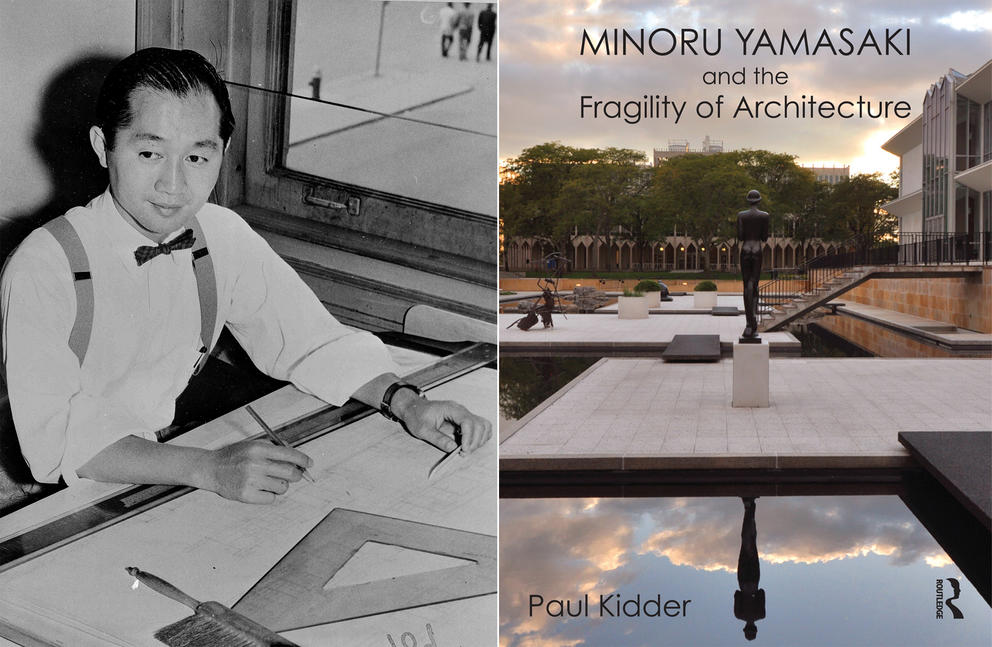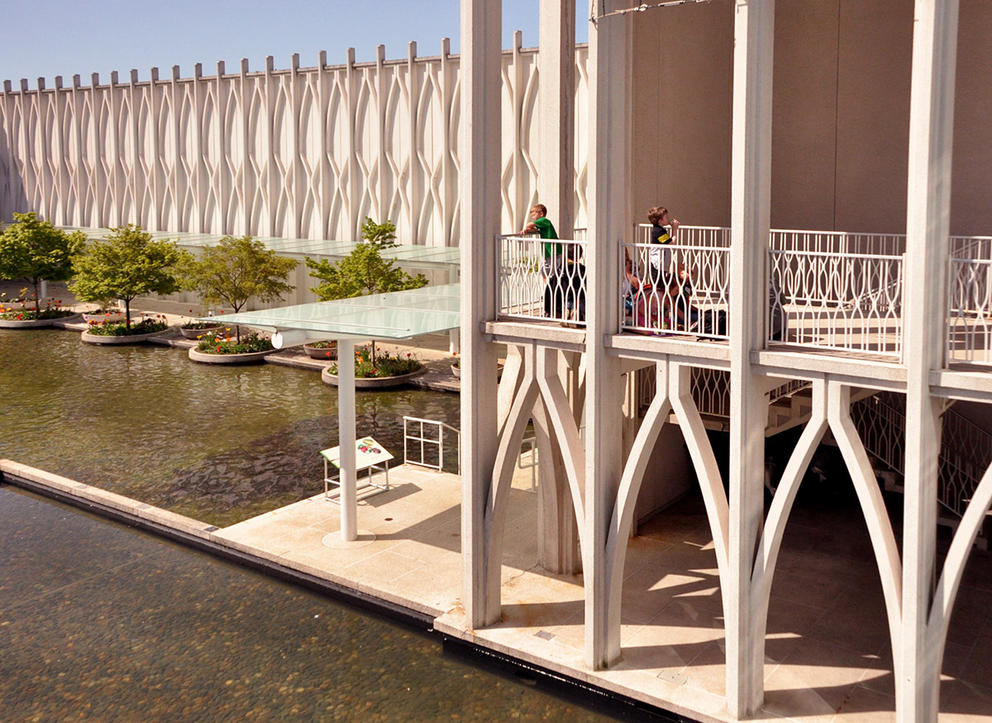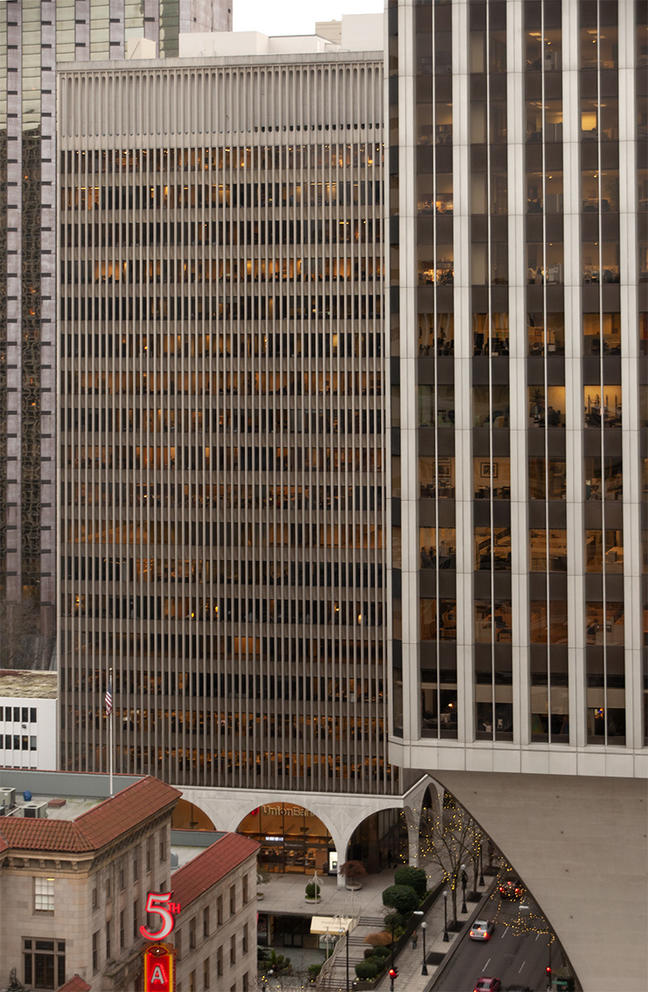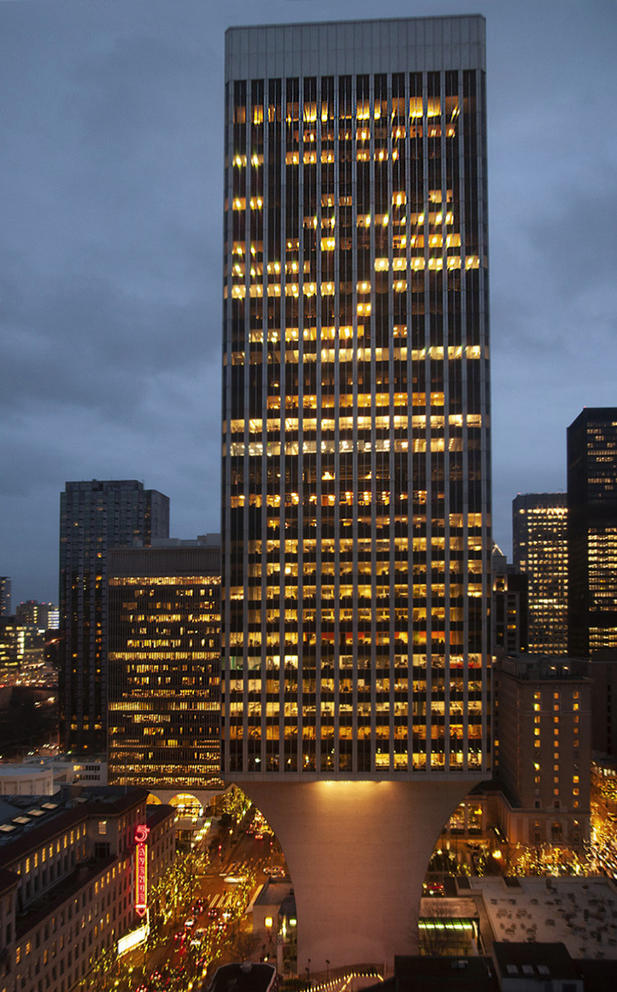The twin tower terrorist attacks were an odd exclamation point to the career of architect Yamasaki, whose works were largely informed by his idealism about the purpose of his craft. Architecture, he once said, “must … fulfill society’s aspirations, its reaching for nobility, its craving for beauty.” And over his long career, those ideals and aspirations helped to profoundly shape his hometown, Seattle.
A new book by a Seattle University philosophy professor looks at Yamasaki’s career — his accomplishments and failures, and the meaning of it all. It’s a reassessment of an architect worthy of serious consideration and a man whose ideas and projects have been beloved by the public, reviled by critics and sometimes demolished. Minoru Yamasaki and the Fragility of Architecture by Paul Kidder is an excellent, thoughtful survey of the difficulties of placing Yamasaki in the pantheon of modern and postmodern architects.
Yamasaki was born in 1912 and raised in Seattle. His family lived “down near the police station” in Japantown, where his father worked as a stock man in a local shoe store. Yamasaki endured anti-Asian racism here. Anti-Japanese sentiment was strong during the years of his youth. He experienced it, too, during summers working “in degrading circumstances” in Alaska canneries; there he fed fish into a machine known by the racist name “Iron Chink” because it replaced the hand work of so many Chinese laborers.
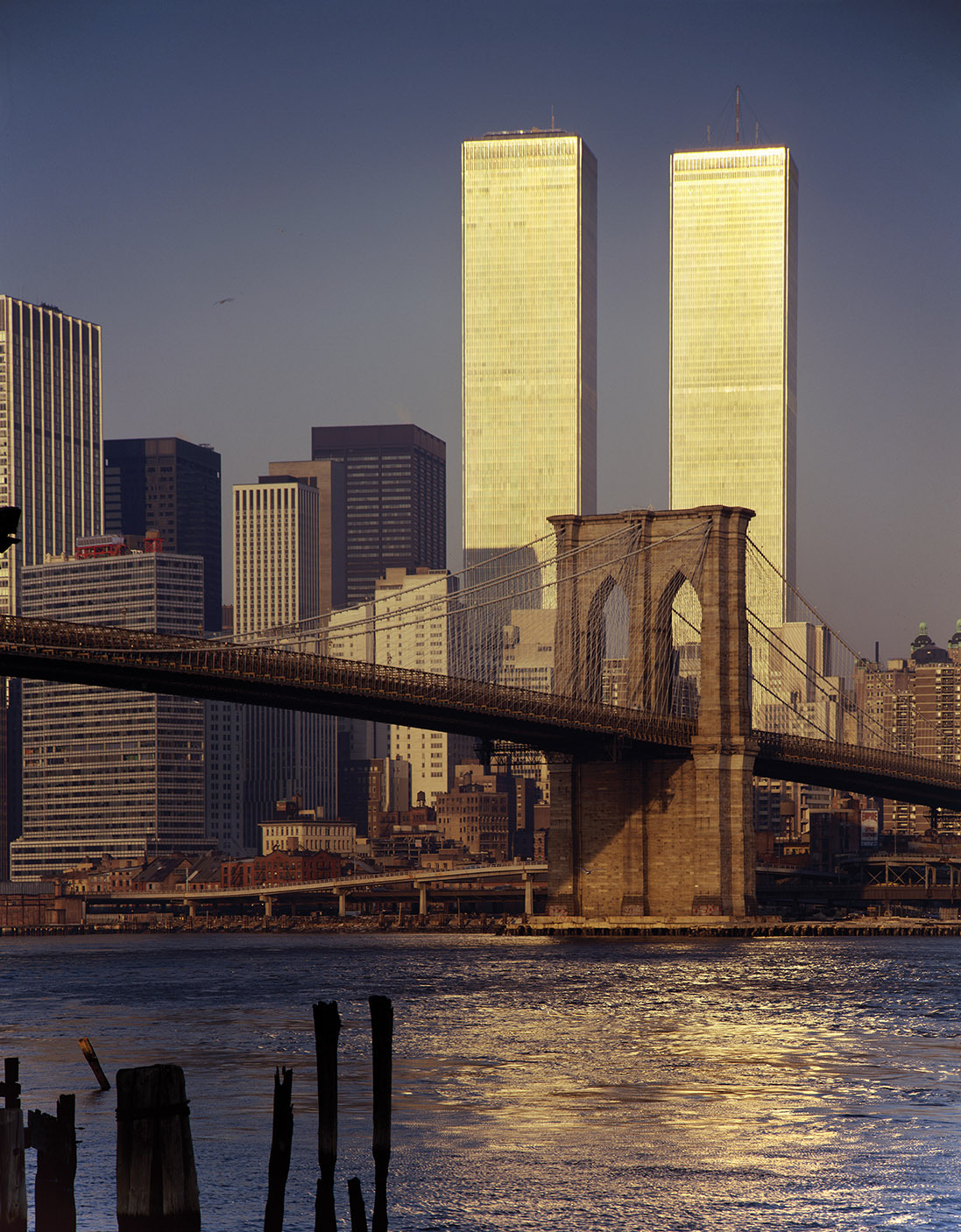
Still, in the midst of the Depression, Yamasaki graduated in 1934 from the University of Washington as a standout student of architecture. He later continued his education in New York. When Pearl Harbor was attacked, he was working on building U.S. military bases in Newfoundland. As a Nisei, he faced suspicion and anti-Japanese sentiment fueled by the war, but the firm he worked for went to bat for him, and he eventually received security clearance to continue. During World War II, he moved his parents back east so they could escape internment in concentration camps established by executive order in 1942.
After the war he set up shop with his own architectural firm in the Detroit area, where he was at first prohibited from owning a home in the fancier suburbs. His work expanded. He did major projects around the U.S. on college campus; he built low-income housing; and he was commissioned to design an impressive modern wing of the St. Louis airport. He traveled overseas and did projects for the U.S. government in both Japan and India. He was inspired by Japanese design and in 1959 said that American architecture could learn from its “quietness and beauty.” His work in India, at a trade fair in New Delhi, brought him to the attention of U.S. officials who wanted a science pavilion at the Seattle’s 1962 Century 21 Exposition.
A sacred space for science
His federal project for Century 21 became the Pacific Science Center, a cluster of white buildings surrounding a series of pools and fountains with tall gothic “space arches” that rise overhead like the skeletal structure of a cathedral. It was a sacred space for science. Seattle architect Paul Thiry, the expo’s main architect, had hoped Yamasaki would take advantage of the site’s high elevation to build a pavilion offering views of Puget Sound and the Olympics. But Yamasaki wanted something like a cloister for contemplation amid the hubbub of the fair — a kind of minimalist, modernist Alhambra.
The science pavilion made the cover of Time magazine, an accolade that helped land Yamasaki the commission to design the World Trade Center. The building in Seattle Center was meant to be converted into a post office, but instead became a popular and permanent science-oriented attraction that inspired others around the country. Time dubbed it a “modern Xanadu built for pleasure and delight, a declaration of independence from the machine-made monotony of so much modern architecture.”
People loved it, but for architectural critics it wasn’t modern, utilitarian or austere enough. Years after the fair, influential San Francisco architecture critic Allan Temko called it “post-modernism in Moorish dress,” and said the gleaming white pavilion was “so sugary that you could put a bride and groom on top.”
Yamasaki’s influence on the fairgrounds went beyond the pavilion. It was Yamasaki who conceived of remodeling the old Civic Auditorium into the Opera House — since remade again into McCaw Hall — to save funds (this triggered a lawsuit that threatened to stop the fair but ultimately failed). He also played the role of peacemaker in bringing warring civic factions together to agree to a plan for Seattle Center, finding a middle path between a site for high culture and one that could attract a broader range of people and users. The center has occupied that middle ground ever since.
Downtown high-rises
After the fair, Yamasaki undertook two downtown high-rise projects. It was during the 1964 construction of the IBM building, on Fifth Avenue, when Yamasaki and engineer John Skilling achieved a major architectural innovation. The two figured out how to make the heavily windowed exterior walls of a high-rise into load bearing walls using “pinstripes” of precast concrete and steel; it was this technique that would become the trademark of the World Trade Center towers.
Today, the IBM tower remains one of the most unpretentious yet elegant high-rises in downtown Seattle. This was the first project Yamasaki undertook on land owned by the University of Washington, the so-called metropolitan tract, a valuable swath of real estate that had been donated in the mid-19th century in order to establish a territorial university for the budding city.
Kitty corner from the IBM building, Yamasaki designed a commercial complex — originally called Commerce House and, later, Rainier Square and Tower — on more metropolitan tract property along Fifth Avenue between Union and University streets. The crowning piece was a white, 40-story office tower cantilevered over a 12-story narrow pedestal. Yamasaki loved the architectural “surprise” that the precarious-looking tower would provide.
This was Yamasaki’s most controversial and divisive work in Seattle. If people loved the Pacific Science Center’s serenity and the IBM’s neat modesty, this showy structure in the heart of downtown elicited attacks.
Local preservationists objected to the site, as it would necessitate the destruction of the venerable turn-of-the-century White-Henry-Stuart Building — actually three conjoined buildings similar to the nearby (and surviving) Cobb Building. It was beloved for its look, history and scale, and its demolition came on the heels of a wave of preservation success in the early 1970s.
The Pike Place Market had been recently rescued from this fate by a public vote, and Pioneer Square was newly designated a protected historic district. Architect Victor Steinbrueck, who had been a leader in protecting both neighborhoods, joined the fight against Rainier Tower in 1974, an effort he hoped would preserve the scale of the neighborhood. He called Yamasaki’s plans “one of the most significant disasters in a modern American city.”
One weapon against the high-rise plans was the newly minted Seattle Landmarks Preservation Board. It explored designating the area of Fifth Avenue, including the metropolitan tract, as a historic district, but the UW and downtown business community pushed back. The university argued that the city had no legal right to tell it what to do with its land grant property, while business wanted the development, especially on the heels of the Boeing recession and loss of commerce and population to suburban sprawl.
The preservation effort was defeated over the objections of Steinbrueck, who had once worked for Yamasaki in Detroit and legendary Seattle architect Fred Bassetti, among others.
Further objections were made by urban architects and critics who objected to the design. In essence, the tower, on its tall pedestal, was surrounded at its base by a large, boxy two-story shopping mall, which moved retail activity off the street, indoors and underground. Yamasaki’s design was seen as enabling the suburbanization of downtown, damaging street retail and human interaction. The Washington Post’s critic, Wolf Von Eckhardt, said the new mall would be a “presumably Muzak-doused suburban concrete oasis with potted plants and look-alike store fronts … and lots and lots of pavement.”
The precarious look of the skyscraper was also decried as a gimmick. The New York Times’ influential critic, Ada Louise Huxtable, disparaged it as a “popsicle” and savaged it by saying it was part of a “discredited architectural game” characterized by “scalelessness, discontinuity, inhumanity and crimes against urban nature.” She hated what it represented. Other critics simply hated it. Von Eckhardt complained about its “architectural exhibitionism.” Temko said he thought it was a response to the racism that the architect had experienced: “I always thought it was Yamasaki’s revenge for discrimination (against the Japanese). … [The] IBM building is also an authentic dog. … [The] buildings are colossal errors.”
Yamasaki envisioned eventually remaking the surrounding properties on the UW’s tract, including the Olympic Hotel, the 5th Avenue Theatre, the Skinner and Cobb Buildings. He found zero merit in the existing structures. As he put it, “The White-Henry-Stuart Building and the Olympic Hotel block do not enhance in any way the experience which should be fundamental to man during the time he spends in the city.”
The project went forward. But preservationists moved to prevent its expansion. The landmarks board began a detailed survey of landmark-eligible structures and looked at protecting at-risk buildings on the UW’s tract. Full-scale redevelopment did not occur, though the mall part of the Rainier complex was eventually razed and a new high-rise was built adjacent, careful not to block the drama of Yamasaki’s tower on its perch.
Architectural 'fragility'
That Yamasaki’s Seattle projects became the subject of national debate is a testament to the importance of his work, but also makes a point of author Kidder’s multifaceted idea he calls architectural “fragility.”
One aspect of it is the reputation of the architect. Yamasaki, educated in Seattle, left and built his career back east, after facing racism and discrimination here. His “return” to town was seen by some as an opportunity for reconciliation and to burnish his local connections. In 1960, for example, he was given the UW’s “Most Distinguished Alumni” award for his national and international work. His profile as a local boy who made good was raised.
But by the 1970s, as the Rainier Tower project showed, the architect who advocated beauty and nobility in design was under attack as a destroyer of his hometown. It was Yamasaki’s last work in Seattle. He was feted in the 1960s, rejected in the ’70s and died of cancer in the mid-1980s.
The World Trade Center attack in 2001 put him briefly back on the map, as people wanted to learn more about the history of the twin towers, how they were constructed and why they came down so drastically. If anything, they became a symbol of tragedy, but also of hubris.
Buildings themselves can be fragile and destructible. Yamasaki’s Rainier Square mall is gone. Yamasaki himself wasn’t at all attached to “old Seattle” — if anything, he was likely somewhat hostile to it based on his past here. For Steinbruek, Bassetti and others, the historic buildings that came down so Yamasaki’s monument could rise also proved the fragility of the past and of the complex urban environment they hoped to cultivate with the mix of new and old.
The strength of architecture is not embedded in foundations, steel, concrete or design, but rather in the meaning a structure embodies. Despite all the rules and guidelines that attempt to turn the preservation of landmarks into a kind of science, the most compelling aspects of historic preservation are wedded to the stories these structures tell. What does it mean to us? How does it make us feel? We can love soaring towers, but also lowly bungalows.
Fragility also comes with the changing dynamics of human circumstance. The decline of church attendance has seen many local churches facing closure or demolition. The Catholic archdiocese has put a number of churches in Seattle and Tacoma on the chopping block. And the pandemic is testing the resilience of iconic historic landmarks like the Pike Place Market and the Space Needle, both of which have been impacted during the pandemic by the disappearance of tourists and cruise ships.
Whole categories of structures, such as our state’s historic theaters, have been closed by the pandemic. They often anchor historic retail districts and, along with them, have suffered from closure, lack of revenue, staff cuts and maintenance backlogs — enough to earn a spot on the Washington Trust’s 2021 “Most Endangered” heritage list. Fortunately, a new state grant program is in the works to help them get back on their feet. The work of “saving” historic buildings or neighborhoods is ongoing; it’s a starting point, not a finish line.
Kidder points out, too, that Yamasaki’s work was about fragility itself. “Arguably the most definitive feature of his style was its embrace of fragility,” he writes. “From very early in his career Yamasaki formed an aversion to what he perceived as brutality in architecture.” Kidd says he eschewed structures designed to defend and intimidate: “Modernity, he thought, should represent everything that humankind has done to move in the opposite direction.” Architecture, in other words, should be a force for civilizing society.
In today’s rough world, in an America where Yamasaki’s work has been demolished by terrorists, and where democratic institutions are under attack and authoritarianism is on the rise, we can appreciate now the fragility and importance of Yamasaki’s aspirations for an architecture of beauty, serenity and ennoblement. Kidder makes the case that reexamining Yamasaki’s work can put us back in touch with the value of architecture that embodies “civilization, humanism, democracy.” It’s not just architecture and reputations that are fragile. We live in destructive times where his ideals need to be reembraced in both philosophical and physical terms.

